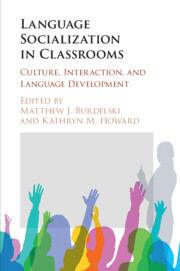Book contents
- Language Socialization in Classrooms
- Language Socialization in Classrooms
- Copyright page
- Dedication
- Contents
- Figures
- Tables
- Contributors
- Acknowledgments
- Transcription Conventions
- 1 Introduction
- Part I Socializing Values, Dispositions, and Stances
- Part II Socializing Identities
- Part III Language Socialization and Ideology
- 9 The Morning Assembly
- 10 Embodiment, Ritual, and Ideology in a Japanese-as-a-Heritage-Language Preschool Classroom
- 11 Talking about Lunch
- Part IV Conclusion
- Index
- References
10 - Embodiment, Ritual, and Ideology in a Japanese-as-a-Heritage-Language Preschool Classroom
from Part III - Language Socialization and Ideology
Published online by Cambridge University Press: 10 February 2020
- Language Socialization in Classrooms
- Language Socialization in Classrooms
- Copyright page
- Dedication
- Contents
- Figures
- Tables
- Contributors
- Acknowledgments
- Transcription Conventions
- 1 Introduction
- Part I Socializing Values, Dispositions, and Stances
- Part II Socializing Identities
- Part III Language Socialization and Ideology
- 9 The Morning Assembly
- 10 Embodiment, Ritual, and Ideology in a Japanese-as-a-Heritage-Language Preschool Classroom
- 11 Talking about Lunch
- Part IV Conclusion
- Index
- References
Summary
This chapter examines the ways teachers in a Japanese-as-heritage-language classroom in the United States prepare children to receive a preschool graduation certificate to be held at the end of the school year. It shows ways this preparation entails children learning an elaborate sequence of embodied moves that have to be imitated and performed in a fixed way (e.g., receiving the certificate from the school principal with both hands, taking a step back and then bowing deeply). It identifies various stages of this instruction, including modeling and demonstration by teachers of explicitly articulated “good”/“correct” and “bad”/“incorrect” examples followed by individual one-on-one rehearsal that entails an abundant amount of verbal and embodied correction of each child’s embodied moves. The chapter argues that teachers’ verbal and embodied practices during this preparation are rooted within an ideology of “correctness” of form (kata) that permeates many of the activities observed in this preschool classroom (e.g., learning to write Japanese, doing origami) in ways that prepare the children for Japanese society, in which attention to details of prescribed form is highly valued.
- Type
- Chapter
- Information
- Language Socialization in ClassroomsCulture, Interaction, and Language Development, pp. 200 - 223Publisher: Cambridge University PressPrint publication year: 2020
References
- 5
- Cited by

